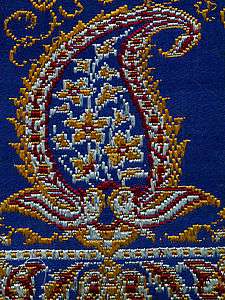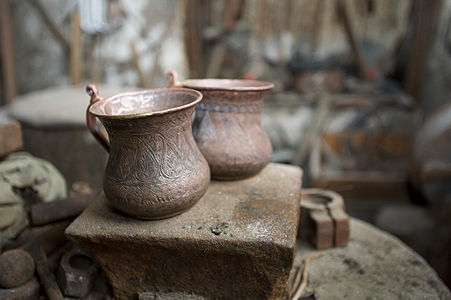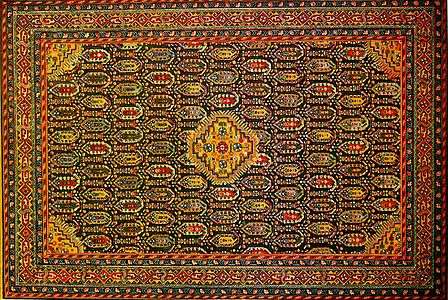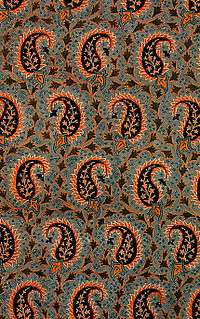Buta (ornament)
The boteh (Persian: بته), or buta (Azerbaijani: Buta) is an almond or pine cone-shaped motif in ornament with a sharp-curved upper end.[1] Though probably of Persian origin, it is very common in India, Azerbaijan, Turkey and other countries of the Near East.[1] Via Kashmir shawls it spread to Europe, where patterns using it are known as paisleys, as Paisley, Renfrewshire in Scotland was a major centre making them.

In Asian ornament the boteh motifs are typically placed in orderly rows, though especially in India they may appear in a pattern in a variety of sizes, colours, and orientations, which is also characteristic of European paisley patterns.
In Azerbaijan buta took deepest root and underwent its most significant development.[2]
History
Though a Zoroastrian origin has been suggested for the motif, it is not found in the remains of old fire temples of that faith. Botehs can be seen carved in the column capitals of the Haji Piyada mosque, Balkh province, northern Afghanistan, which was built in the 9th century.[3]
Some design scholars believe the buta is the convergence of a stylized floral spray and a cypress tree: a Zoroastrian symbol of life and eternity.[4] The "bent" cedar is also a sign of strength and resistance but modesty. The floral motif was originated in the Sassanid dynasty and later in the Safavid dynasty of Persia (1501–1736), and was a major textile pattern in Iran during the Qajar and Pahlavi dynasties. In these periods, the pattern was used to decorate royal regalia, crowns, and court garments, as well as textiles used by the general population. Persian and Central Asian designs usually range the motifs in orderly rows, with a plain background.
Uses
The motifs can still be found on Persian carpets, Azerbaijani rugs, kalaghai shawls and textiles, paintings of decorative-applied arts of Greater Iran (Iran, Azarbaijan, etc) and also in decorations of architectural monuments. It is widespread in Ganja, Azerbaijan, where it has been an integral part of carpet ornaments.[1]
It is woven using gold or silver threads on silk or other high quality textiles for gifts, for weddings and special occasions. In Iran and Uzbekistan, its use goes beyond clothing, with paintings, jewelry, frescoes, curtains, tablecloths, quilts, carpets, garden landscaping, and pottery also sporting the buta design. In Uzbekistan the most frequently found item featuring the design is the traditional doʻppi caps.
In Tamil Nadu the manga maalai (mango necklace)[5][6] with matching earrings is a traditional feature of bharathanatyam dance.[7] It is a prominent design in Kanchipuram saris.[8][9][10][11] It has sometimes been associated with Hinduism.[12]
Patterns and ornaments of buta motifs can be found on Azerbaijani rugs, kalaghai and textiles, paintings of decorative-applied arts of Azerbaijan and also in decorations of architectural monuments.[13] This motif is considered as the most ancient among all national ornaments of Azerbaijan.[14] There are many printed items decorated only with buta.[14] Buta is displayed in the emblem of the 2012 FIFA U-17 Women's World Cup, which was held in Azerbaijan.
Gallery
- Silk sari with mankolam design, made in Kanchipuram
 Persian silk brocade from the Pahlavi Dynasty.
Persian silk brocade from the Pahlavi Dynasty.
 Buta on copper items in Lahij
Buta on copper items in Lahij Buta on Azerbaijani carpet made in the 18th century, in Baku
Buta on Azerbaijani carpet made in the 18th century, in Baku Persian silk brocade with golden thread (golabetoon), woven in 1939
Persian silk brocade with golden thread (golabetoon), woven in 1939
References
- Н. Самгнна. (1995). Ковры типа Фахралы. 56. Сообщения Государственного Эрмитажа: Искусство. p. 59.
- Latif Karimov (1987). "Buta". 3. Oriental Carpet & Textile Studies. p. 78..
- Novin, Guity, "A history of Paisley or Boteh Jegheh Design", Ch 92 in A History of Graphic Design.
- Indian Hand Woven Jacquard Jamavar Shawls, Zanzibar Trading.
- "22Kt gold Mango Mala necklace from India on Jewel of the Lotus". Asian art. Archived from the original on 2013-06-25. Retrieved 2013-03-11.
- "Traditional Jewels of India". Jewels in India. Retrieved 2013-03-11.
- "Blue stones Mango Necklace Temple Bharatanatyam Jewelry". Vadaamalar. 2011-01-08. Retrieved 2013-03-11.
- Sarumathi, K (2012-08-12). "M.S. blue, mango motif still in vogue". The Hindu. Retrieved 2013-03-11.
- Trends, Desi (2012-06-15). "Jayapradha Red Kancheepuram Bridal Sari | Saree Blouse Patterns". Celebrity saree. Retrieved 2013-03-11.
- "Image 14620652". Kanchipuram Silk Saree Stock Photography. Dreams time. 2010-04-24. Retrieved 2013-03-11.
- "Sareeslook sarees". Picasa Web Albums. 2009-11-13. Archived from the original on 2013-01-24. Retrieved 2013-03-11.
- "Image of the Mankolam Design". Sacred Symbols of Hinduism. About. 2012-04-10. Retrieved 2013-03-11.
- В. Лобачев. (1975). Магия подзаголовка. Книга. p. 190.
- Г. А. Гулиев. (1964). Об азербайджанской набойке. Советская этнография: Издательство Академии наук. p. 134.
Sources
| Wikimedia Commons has media related to Boteh. |
- F. Petri «Origin of the Book of the Dead Angient Egipt». 1926. June part 2 с 41-45
- С. Ашурбейли «Новые изыскания по истории Баку и Девичьей башни» Альманах искусств 1972 г, С.Ашурбейли «О датировке и назначении Гыз галасы в крепости» Элм. 1974 г.
